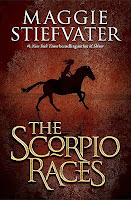Bibliographic Information: Klages,
Ellen. The
Green Glass Sea. New York: Puffin, 2012. ISBN: 9780142411490.
Plot Summary:
Dewey Kerrigan’s dad works on a secret mission with the
army. Dewey was living with her Grandma
until she had a stroke and had to temporarily move in with a neighbor. Soon a stranger from the army picks up Dewey
and sends her on a train to the west.
Dewey thinks she is meeting her dad in Chicago but comes to find out
that she is going all the way to New Mexico.
Dewey’s life is turned upside down.
She tinkers on the train with her radio to help bring some normalcy to
her routine.
Eventually, Dewey is reunited with her father in a small
town in New Mexico. She is whisked away
to a secret location that requires an identification card even for her to get
in. Her dad and others are working on a
secret device behind the gates of Los Alamos.
Dewey tries to make herself at home with her tinkering. Finally, when she begins to feel comfortable
at home behind the walls with the scientists her dad is sent away on a trip.
Dewey is sent to live with some of her father’s friends and finds herself in
another home that feels temporary. Dewey
and Suze are thrown together in an unexpected friendship when Dewey’s life is
turned upside down. She finds a good friend when she least expects it. Together they rejoice that the scientists successfully created their machine which was the
atomic bomb.
Critical Analysis:
Dewey Kerrigan is a realistic character that at any point in
history would be a believable character. She is a young girl trying to fit in, make friends, and connect with
family. Young readers are probably not
familiar with Los Alamos and the secret of the “Hill”. Klages does a great job of creating the
setting of the story with description of shopping at Woolworths to going to the
commissary for a coke.
The plot is expertly shown through the eyes of the children
Suze and Dewey as the scientists create the gadget that is meant to change the
world. Readers will be just as amazed
when the scientists discovered it worked and was a success. Young readers will be engaged as the secret
is revealed for all to see.
The setting from the train to the “Hill” was perfectly
described for someone who was not familiar with Los Alamos. The author explains how the military housing
looked from “bathtub row” to the smaller apartments. She emphasized the secrecy of the location
from the need to have an id to come in and no visitors allowed. These details really put the location into
perspective for someone who is not familiar with it.
The style of the story was a great coming of age story that
included finding friendship and discovering what is important in life when it
seems like not a lot is left. Klages
does a fantastic job of weaving historical details into Dewey’s story.
The author’s note explains in plain language to the reader
about the Manhattan project at Los Alamos and how these locations did not show
up on a map. The author gives a list of
sources should a reader want to look more into the history of the project and
life on the “Hill.” Her acknowledgements
explain how she came up with the authentic pieces of 1940’s history to make
everything from the past come to life.
Awards and Reviews
Scott O'Dell Award (2007)
Rebecca Caudill Young Reader's Book Award Nominee (2009)
Judy Lopez Memorial Award for Children's Literature (2007)
SCHOOL LIBRARY JOURNAL:
“Grade 5-8–Two girls spend a year in Los Alamos as their
parents work on the secret gadget that will end World War II. Dewey is a
mechanically minded 10-year-old who gets along fine with the scientists at the
site, but is teased by girls her own age. When her mathematician father is
called away, she moves in with Suze, who initially detests her new roommate.
The two draw closer, though, and their growing friendship is neatly set against
the tenseness of the Los Alamos compound as the project nears completion. Clear
prose brings readers right into the unusual atmosphere of the secretive
scientific community, seen through the eyes of the kids and their families.
Dewey is an especially engaging character, plunging on with her mechanical
projects and ignoring any questions about gender roles” Steven Engelfried, Beaverton City Library, OR
BOOKLIST:
“There are lots of people to talk with about
radios (including "Oppie"), and she has the wonderful opportunity to
dig through the nearby dump for discarded science stuff. However, when Dewey's
father leaves for Washington, she is left to fend off the biggest bully in Los
Alamos. The novel occasionally gets mired down in detail, but the characters
are exceptionally well drawn, and the compelling, unusual setting makes a great
tie-in for history classes”. John Green
Connections:
Pull the companion book in the series:
White Sands, Red Menace ISBN 0670062359
Have
students create a diorama about Los Alamos, the atomic bomb, or the 1940’s.
Pull
other Scott O’Dell Winner books set in WWII:
Dash ISBN 0545416353
The Art of Keeping Cool ISBN 0689837887
The Bomb ISBN 0380727234
Under the Blood Red Sun ISBN 0553494872
Mail
from the “Hill” was censored. Try
writing a letter to a friend or a relative that doesn’t reveal anything about
your location or anything important that could be censored. Reflect on how hard this would be with today’s
technology such as text messaging,
If
possible, have an example or at least an electronic example of original comics
and have students compare them to the comics of today.
Show
the students on a virtual map where Los Alamos, Trinity and where the atomic
bombs were dropped.
References:
“The Green Glass Sea”
Amazon Editorial Reviews. Accessed April
4, 2017. https://www.amazon.com/Green-Glass-Sea-Ellen-Klages/dp/0142411493/ref=sr_1_1?ie=UTF8&qid=1491348797&sr=8-1&keywords=green+glass+sea




Comments
Post a Comment